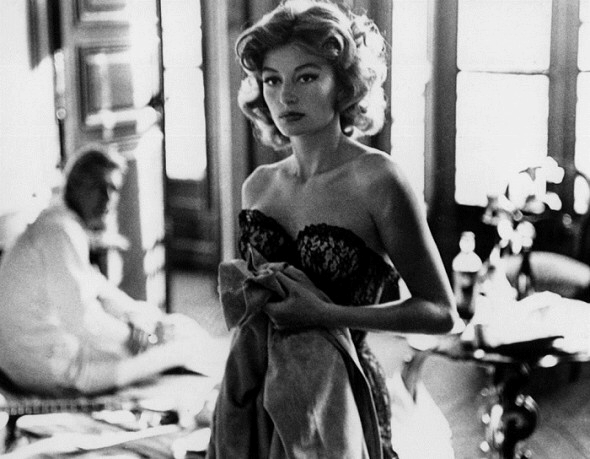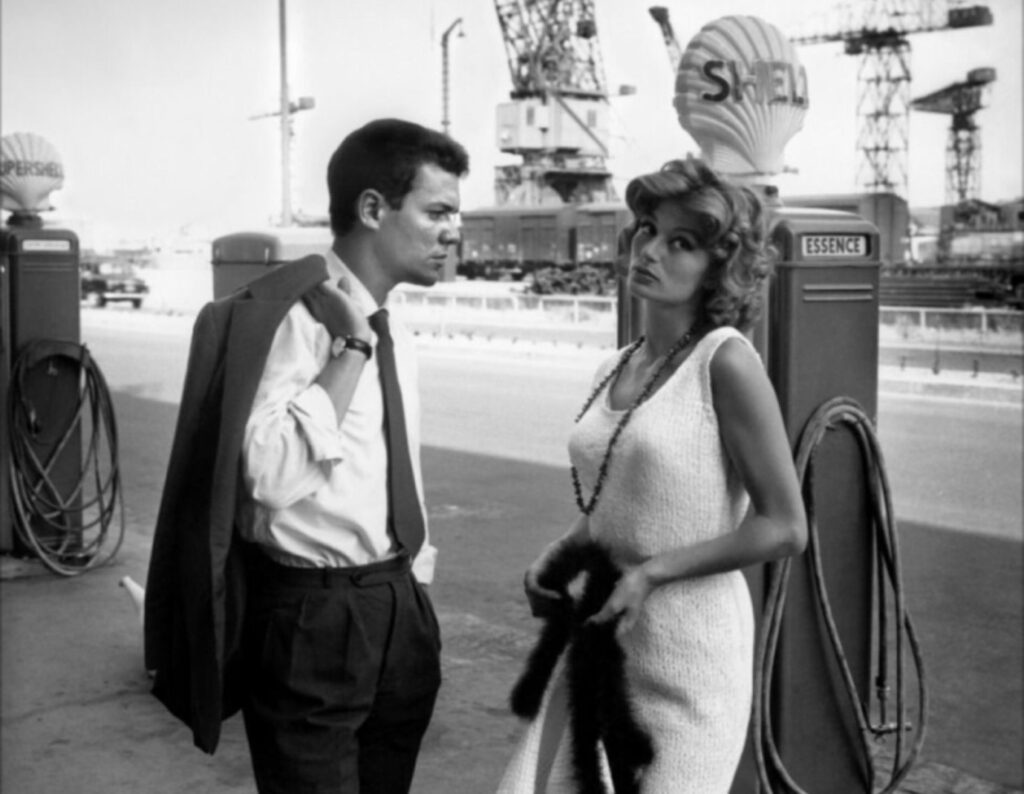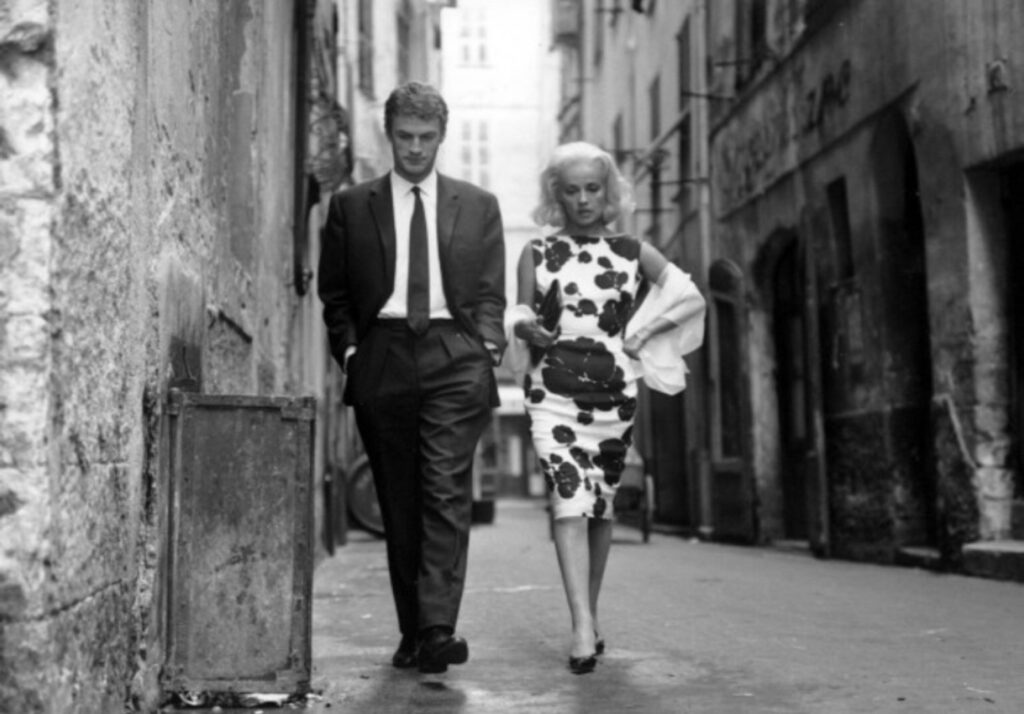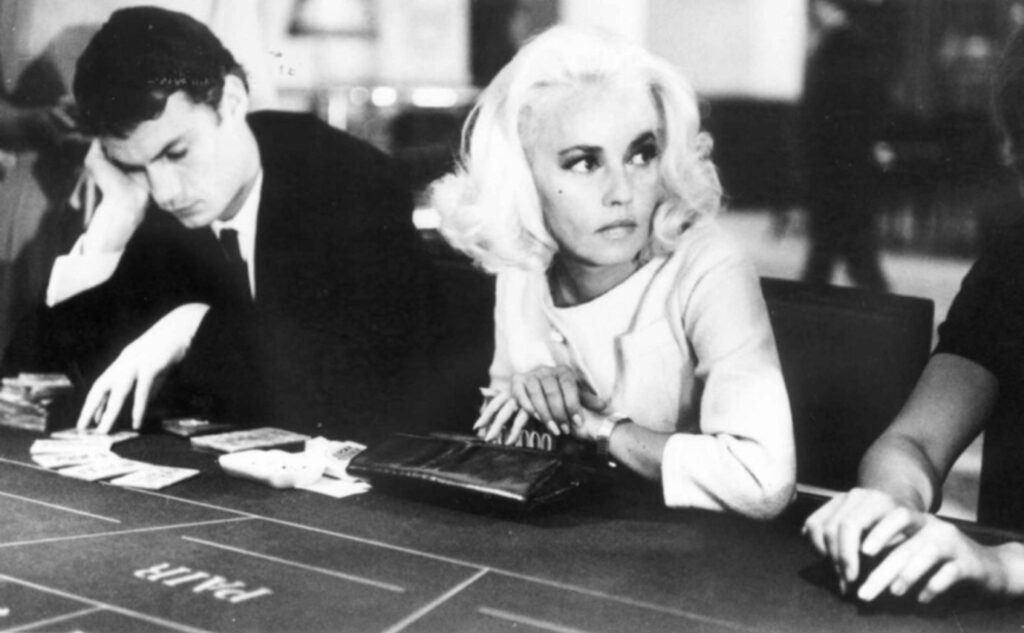Before using colours “like a singing Matisse” in The Umbrellas of Cherbourg, Jacques Demy made the most lyrical use of black and white in his first two films, Lola and Bay of Angels. Before singing heroines bursting on screen on a background of glorious colours and stylised sets (the citizens of Cherbourg allowed Demy to paint their houses) that paid homage to classic Hollywood musicals, a different kind of heroine glided through Demy’s fictional universe: one clearly born in the French New Wave, but one who quietly sang and danced on her own music.
Lola takes place in Demy’s native Nantes, an unremarkable provincial town port, a realistic setting but into which the film-maker introduced an air of fairy-tale romance. Demy wanted Lola to evoke “memories from Nantes, from the time when I was in college and bunked off school to go to the movies.” Filmed in black and white by Raoul Coutard, it is our first encounter with Demy’s singular, fascinating universe, dreamed up by a dreamer and shaped up by a craftsman, that balances melancholy with hope and vivacity, filmic artifice with emotional authenticity, the quest for love and happiness with the realities of everyday life, where music and dance are already informing, although in a subtle way for now, plot and characterisation – “a musical without music,” is how Demy described his first feature film. It was “full of music in all its silence,” felt composer Michel Legrand when Jacques Demy screened it to him.
“In the films, it’s always beautiful,” declares Jeanne, one of the characters in Lola, channeling Demy’s drive to and draw from cinema. His cinema is one of an auteur, but also one of a cinephile – there is a clear allusion to the American dream as well as to other films (Demy’s Lola is a tribute to Max Ophül’s 1955 Lola Montès and also references Josef von Sternberg’s 1930 The Blue Angel and his Marlene Dietrich as Lola Lola) and at the same time it previews future Demy themes when one of the characters mentions Cherbourg, and also that her husband was a gambler, anticipating the subjects of Demy’s next two films, Bay of Angels (1963) and The Umbrellas of Cherbourg (1964).

Cabaret dancer and single mother Lola (Anouk Aimée) is waiting for the return of her long-gone true love while being suited by an American sailor, Frankie (Alan Scott), and her old friend, love-struck Roland Cassard (Marc Michel) – Demy’s alter ego – who gets fired and the only thing he sees fit is going to the Cinéma Katorza to see Return to Paradise (1953). A saddening awareness of the transience of happiness and of the fragility of love pervades the film. Suggestively set in a port city, it is a story where everyone is wistful, longing for someone or something different, and on the move, either dancing or getting from one place to another in town, or waiting to sail off home, or transiting the city on the way to another gig or business. They are passers-by… through life, through love. Everybody seems to be searching for love, but nobody finds it. “There is a little happiness in wanting happiness.”
Lola is part ingénue, part sexual attraction, part mother figure and part mythical creature, the pure creation of Jacque Demy’s unique universe. But it is the fact that she is an incurable romantic that ultimately defines her as an ethereal identity. “When Jacques gave me Lola, he gave me a marvelous gift,” Anouk Aimée remembered. “A character completely unlike what I’d done before. I’d always played the ingenue, the girl in love. This character was so original. One of those characters he would create, who stepped out of one of his poems. There was such poetry to it all. That’s what helped me walk around with my nylons and move around like that.”
Her clothes are much part of this image. For much of the film, we see her – tall, slim, black-haired – in her signature sexy, black lace corset, black nylons, black fur boa and black pumps. Not even when she goes home to her son does she change, but simply covers herself with a coat. A trench coat, naturally. Later on, she playfully pairs her outfit with Frankie’s white sailor shirt and cap. But when she goes out with Roland, she wears a simple and elegant white crocheted dress and matching jacket, contributing to her suitor’s initial vision of her as a celestial creature (her real name is Céline). The black fur boa on her jacket neckline though is a constant reminder of her other side as entertainer.

In an interview with Agnes Varda, Anouk Aimée recounted how the producers didn’t find her sexy enough, or beautiful enough, because she did not fit in the beauty canons of the time, and how Demy fought for her. “I’ll never forget that,” she said. He had envisioned her as this original character and Jean-Louis Trintignant told Aimée that the director wanted to meet her. “Lola is such a part of me that I can’t tell which part is her and which is me. We’ve grown so close that we mimic each other,” Aimée candidly confessed. Maybe that’s why she made such a fantastic creature believable, both ideal vision of femininity and pure cinematic fabrication, “devoid of any kind of aggressiveness or vulgarity or exhibitionism.” Demy told her to think of Marilyn Monroe while playing her character, which she did, and it helped. “I should sew some fancy stuff on mine. Something flossy, you know? And something glittery here. It’d look great. And a big plume like Marilyn Monroe’s,” fancies Lola. Anouk Aimée became the first heroine of Jacques Demy’s visual poems. But her voluble, charming, unpolished performance is one of the defining traits of the New Wave heroines, too, thus firmly establishing her as a Nouvelle Vague icon.
In the sublime La baie des anges (Bay of Angels), at its 60th anniversary in 2023 and which has not dated one bit in all these years, Jeanne Moreau pursues the goal of a doomed and reckless passion. She is Jacqueline Demaistre, or Jackie, a compulsive gambler. “I wanted to lay bare the workings of a passion” said the director. The gambling passion devours everything in Jackie, “it’s that expectation of something mysterious, it’s like a rite, a ritual”, explained Jeanne Moreau. “Gambling is my religion,” Jackie confesses, “money means nothing to me.” Beautifully shot in crystalline black and white (this time by Jean Rabier), the film is a rigorous work of art that paints an otherworldly atmosphere that delves into the mystique of gambling and is a demonstration of Moreau’s cinematic personality. Because Jeanne Moreau is the soul of the film, in the true vein of all Demy’s movies, as each of them is centered around a female character.

Jean Fournier (Claude Mann) is a bank clerk in Paris, bored with his job (he had already once run away from a life “with no risks, no surprises”), who reluctantly tags along his friend to a casino. He tries to remain cautious but immediately, decidedly becomes hooked and sets off to the gambling palaces of the Riviera, where he meets Jackie. And so he is introduced to a lifestyle he confesses he didn’t know “existed anymore… except in the movies or certain American novels” and they become this obsessed couple (with each other and with the spinning roulette), living in their own world, a world where Chance seems to be the only rule to live by (“You must never let luck pass you by,” Jackie tells Jean), and Michel Legrand’s theme music, repeatedly, obsessively playing like a ballad whenever they are winning or every time they find each other, keeps them in this dreamlike blur. Because one thing Demy’s heroine is in Bay of Angels is a femme fatale. She “embodies sin for him, but she does not know it”.
But her personality isn’t laid bare, she is an enigma, she has an electric unpredictability, there is something not quite real about her. Her appearance, from her Marilyn Monroe hair and make-up and gestures (Demy retains his passion for American movies and for Monroe from Lola), to the impeccable elegance (Demy wanted Jeanne Moreau’s costumes only in black and white and he chose Pierre Cardin to design them, from her white deux-pièces, to her floral print dress and the black gown accessorized with a black and white feather boa), is clearly a creation of her artist’s imagination. But the beauty of this character is that she believes in who she is, she believes in walking on sand in high heels, and we believe it too. Her look is make-believe, but also a well thought-out survival technique, it is formal elegance, but also a façade, a front to mask a reality that is less than pretty. She is dressed to the nines in her perfect white suit, but it’s about the only one she’s got and she wears no jewellery because she sold it all in need of money for gambling, and in a moment of sincerity she tells Jean: “I sometimes feel rotten inside.”
She puts on the best face in front of anguish and shadow, in front of the ephemerality of life. The plot is, after all, only briefly set in Paris, then, as it usually is in Demy’s films, moves on the waterfront, to Nice and Monte Carlo, and the universe it evokes is hardly realistic, but provisional, otherworldly. So is Jackie. She is uniquely herself. “I don’t owe anyone anything. Why deny myself the passion? In whose name? I’m free!” And everything about Jackie and Jean is evanescent, everything happens on the spur of the moment, nothing but the present matters. Because Demy’s films are more concerned with poetic momentum than progressive narrative, much more aware of our fleeting happiness and existence than the more colourful, luminous, yearning romanticism of his later works may allude to.

